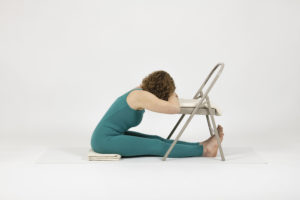
by Nina
As I mentioned in my post Structural Conditions That Affect Your Knees, hyperextension in the knee joints means that your knee joints have a slightly greater range of motion in extension (that is, when you “straighten” your knees) than the average person’s does. In other words, in people with hyperextension of the knees, when their knees are straight, instead of the thigh bones on top and the shinbones on bottom forming one straight line, your knee joints bow slightly backwards. In addition, when your knees are hyperextended, your kneecaps don’t face straightforward; instead, they turn in slightly, with the inner edges pressing back more than the outer edges (making you look a bit knock-kneed). If this sounds like your knees, see Structural Conditions That Affect Your Knees for a test to see if you have hyperextension of the knees or knock knees.
The problem with this structural condition is that you tend to bear more weight on your heels than on the balls of your feet and your thighs are not directly aligned with your shins. You can see this in this photo of me from several years ago—yes, I have this condition—where I’m bearing most of my weight in my heels.
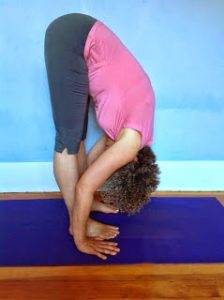
And all of this unevenness in your legs, knees, and feet could lead to uneven wear and tear on the cushioning cartilage of your knee joint, which could result in dysfunction and pain in the future.
However, rather than simply avoiding poses where you tend to hyperextend your knees, by observing the unevenness in your legs, knees, and feet, and making adjustments, you can bring your legs, knees and feet into a healthier alignment.
I’ll start by discussing how to make adjustments to your knees in standing poses, addressing both straight leg poses and bent knee poses, and then provide a suggestion for working with your hyperextended knees in seated poses.
Adjusting Your Knees in Straight Leg Standing Poses
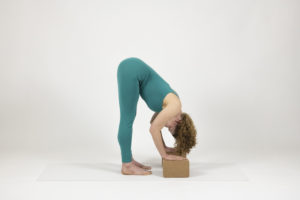
There is a simple technique you can use to correct your hyperextended knees as you practice any straight-legged standing pose.
In Mountain pose, Standing Forward Bend, or any other pose where you are standing on two straight legs, try the following:
- Bend both knees by moving your shins forward and shift some of your weight from your heels to the balls of your feet.
- Then straighten your knees by lifting from your thighs, while keeping some of your weight in the balls of your feet.
And in any pose with a straight leg, even balancing poses such as Tree pose (Vrksasana), you can slightly bend your knee and then straighten it again using this same technique. Years ago I tested this technique with every single standing pose in Light on Yoga, and found benefits in almost every single pose. In many poses, such as Dancer’s pose (Natarjasana), this adjustment brought me deeper into the pose!
Second, without bending your knee, you can try softening your front thigh muscles (quadriceps) and allow your thighbone (femur) to move slightly forward so it aligned more directly over your shinbone and more weight moves onto the ball of your foot. This will bring your leg into a straighter alignment. When I learned about this technique, I found it worked well in Half Moon pose (Arda Chandrasana).
You can also make this same adjustment as you move into standing poses, which allow you to align your knees as you enter the pose rather than after you’re already in it.
Moving Into Straight-Legged Poses
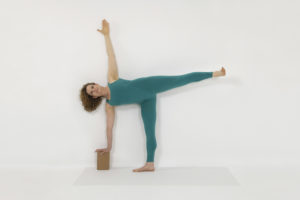
For poses where you normally bend one leg before moving into the pose, such as Warrior 3 (Vrbradrasana 3) or Half Moon Pose (Arda Chandrasana), you can make this adjustment as you move into the pose.
- As you bend your knee, move your shin forward and shift some weight onto the ball of your foot.
- Then, as you straighten your leg to come in the pose, you lift from your thigh to straighten your knee as you keep some weight in the ball of your foot.
- As you come out of the pose, use the same techniques to bend and then straighten your knee.
For poses where you normally move into the pose with a straight leg, such as Triangle pose (Trikonasana) and Pyramid pose (Parsvottanasana), you can try changing the way you move into the pose by bending the front knee first instead of keeping the front leg straight. This is because it is the front knee in these poses that you tend to hyperextend. Yes, this is highly irregular, but I’ve been doing it for years now and I feel good about protecting the health of my knees in this way.
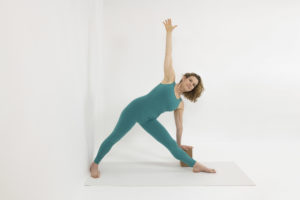
Using Triangle as an example, you would take the foot position for the pose and raise your arms out the sides. Then, bend the knee of your front leg by moving your shin and shifting some weight onto the ball of your foot. Next, as you come into Triangle pose, lift from your thigh to straighten your knee as you keep some weight in the ball of your foot. Does it feel different to you?
Adjusting Your Knees in Bent Knee Poses
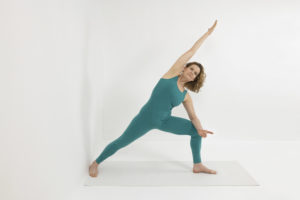
People who hyperextend their knees tend to have knees that turn in slightly. So in weight-bearing poses with bent knees such as Warrior 1 and 2 (Vrbradrasana 1 and 2) or Extended Side Angle pose (Utthita Parsvakonasana), it’s a good idea to try to ensure that you’re bearing the weight evenly on your bent knee. Use the same technique of entering the pose I described above for straight leg poses as you bend your knee to move into the pose.
- Bend from your shin and moving some weight onto the ball of your foot.
- As you bend, pay attention to your inner back knee, deepening it as much as your outer back knee.
- This will help align your kneecap directly over your second and third toes and distribute your weight more evenly.
Obviously, you can do the same thing for both bent knees in poses such as Powerful pose (Utkatasana) or Goddess pose.
As you come out of the pose, use the same technique to straighten your leg as I described above, lifting from your thigh while keeping some weight on the ball of your foot.
Adjusting Your Knees in Seated Poses

In seated poses with one or more straight legs, including forward bends and twists, people with hyperextension of the knees tend to press the knee of their straight leg down toward the floor when their foot is fully flexed (vertical), hyperextending the knee. So, instead of flexing your foot in these poses, try pushing the ball of your foot a bit past your heel (without pointing your toes).
I call this the “Barbie foot,” as it looks like the doll’s feet without her high heels on, and I’ve noticed Iyengar uses this foot position. The result is that your knee no longer hyperextends and—additional bonus!—your hamstrings soften a bit because pressing your front foot forward loosens the tug on the calf muscle, which then loosens the tug on the hamstrings, allowing you to come more deeply into forward bends.
Thank you, Donald
I’d like to end by saying that I learned almost all of this from my teacher Donald Moyer, both while I was training with him to become a yoga teacher and in his ongoing classes. I’m very grateful for all that and more….
• Follow Yoga for Healthy Aging on Facebook and follow Nina on Instagram • Order Yoga for Times of Change here and purchase the companion videos here • Order Yoga for Healthy Aging: A Guide to Lifelong Well-Being here.


Thanks for finally addressing this issue. If you could also address how to do yoga with other hypermobile joints that would be fabulous as well. I didn’t realize that I was hypermobile until I became a yoga instructor myself. And it seems like no one out there ever addressed it, they just told you I’m moving to the full extension of the pose. Consequently, I have ongoing issues from years of not realizing what was going on. It drove me away from my mat. I have just now had the courage to try to go back to my mat and figure out how to do it.
Hi Kara! We do have this article on hypermobility from a few years ago: https://www.yogafortimesofchange.com/are-you-overly-flexibile/